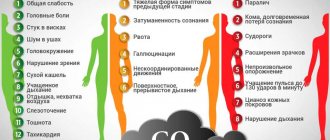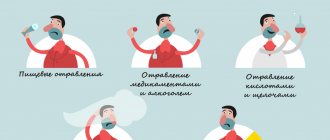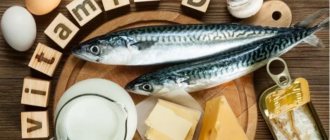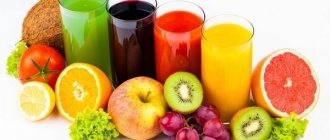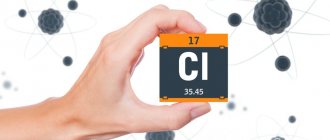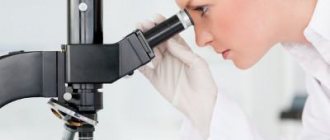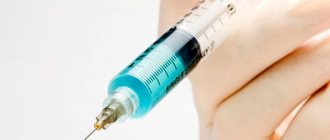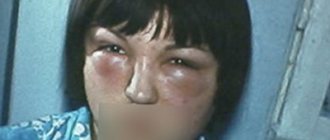Causes of food poisoning
Poisoning can be due to various reasons. There are toxic infections and toxic poisonings.
Foodborne toxic infection occurs as a result of pathogenic microorganisms entering the gastrointestinal tract (GIT) with food. As a rule, the causative agent is pathogenic bacteria that multiply in products if they are improperly stored or get into ready-made food if it is not properly processed.
Toxic poisoning can be caused by various poisons - chemicals or natural toxins found in poisonous berries, mushrooms and many other foods.
The greatest danger from the point of view of food poisoning is represented by perishable foods: fish, meat, milk, salads, etc. Also, eggs, home-canned food, fruits and vegetables with a high content of nitrates, poisonous mushrooms and berries, raw beans, sprouted green potatoes and insufficiently washed raw vegetables and fruits can lead to food poisoning.
It is not recommended to consume products that have expired, are in swollen jars, are in damaged original packaging, or have an unusual appearance, smell, consistency and color.
Diet after poisoning
What can you eat and drink during and after poisoning? You should not eat food on the first day. It is necessary to drink water and special saline solutions frequently. At the first signs of poisoning, it is recommended to take natural sorbents, such as Filtrum. The filter helps remove pathogenic bacteria and bacterial toxins from the body.
Filtrum is a quick remedy for the treatment of diarrhea of any etiology (infectious diarrhea - loperamide is contraindicated, parasitic or rotavirus infection - antibiotics are useless, activated carbon is ineffective)
What can you eat next?
Summary table of nutrition after poisoning
| 1 day | Day 2 | Day 3 | 4 day | 5 day |
| you can't eat anything | vegetable broth | vegetable broth | chicken bouillon | chicken bouillon |
| vegetable puree | vegetable puree | vegetable casserole | vegetable casserole | |
| crackers | crackers | fish | rice porrige | |
| rice porrige | crackers | crackers | ||
| rice porrige | boiled fish |
On the second day it is recommended:
- 200 ml vegetable broth;
- 2-3 crackers;
- 100 ml liquid vegetable puree.
The amount of liquid is up to 2 liters. You can drink boiled water, rosehip decoction, alkaline mineral waters without gas, saline pharmaceutical solutions.
On the third day, you can introduce cereals into your diet.
Proper volume of products:
- 200 ml vegetable broth;
- 300 g of rice porridge, liquid and boiled in water;
- crackers (up to 4 pcs.) and biscuits (2-3 pcs.).
Starting from the fourth day, the volume and list of products expands, it is possible to add chicken broth and lean fish (pike perch).
Daily ration:
- 200 g vegetable casserole with semolina (without eggs),
- 100-150 ml of chicken broth (bring to a boil for the first time and drain the broth, pour water over the chicken again and prepare the dish);
- 100 g boiled fish;
- crackers (4-5 pcs.) and biscuits (5-6 pcs.);
When preparing fish and chicken broth, do not add vegetables or spices, just add a little salt.
On the fifth day, it is necessary to continue expanding the diet. Recommended dishes include chicken, rice, and cottage cheese:
- 300-400 ml chicken broth with chicken meatballs;
- 200-300 g boiled rice;
- 200-300 g casserole or cottage cheese soufflé (without eggs);
- crackers up to 5-6 pcs.
Signs of food poisoning
Symptoms of poisoning are largely similar, regardless of the cause. They are distinguished by intensity and severity depending on the type of toxic substance, age (poisoning in an adult is easier than in children and the elderly) and the amount eaten. However, signs of an inflammatory process in the walls of the intestines and stomach, as well as manifestations of general intoxication of the body, almost always occur.
Signs of poisoning:
- chills, diarrhea, nausea with vomiting;
- feeling unwell, malaise, weakness;
- bloating, painful cramping sensations;
- rise in temperature (usually small).
Severe poisoning, for example, with botulinum toxin, is accompanied by symptoms of damage to the nervous system:
- dry mouth and difficulty swallowing;
- muscle weakness;
- blurred vision, double vision;
- loss of coordination of movements.
Drug intoxication: what is it?
Drug intoxication is a pathological condition based on dysfunction of all organ systems. May be acute or chronic. The severity depends on:
- type of drug;
- duration of use;
- dosage;
- composition of the drug;
- the presence of diseases of internal organs.
Symptoms may appear instantly or develop progressively over several hours. Unfortunately, most drug addicts confuse the signs of poisoning with the effect of the drug and do not seek help, which is why death is a common outcome.
Causes of drug intoxication
Among the most common causes of drug poisoning are:
- overdose;
- low quality of the drug;
- simultaneous use of several types of drugs;
- taking the usual dose after a long break or detoxification;
- using a substance during illness;
- human inexperience;
- the presence of unfamiliar toxic additives in the composition.
Of particular danger is mixing the drug with alcohol, as a result of which the effect is enhanced several times.
HOW TO MOTIVATE A DEPENDENT FOR TREATMENT
Signs of drug poisoning
The symptoms of drug poisoning are different and depend on the type of active component. In general terms, the following signs of intoxication can be identified:
- dilated/constricted pupils;
- pale skin;
- decrease/increase in blood pressure;
- increased/decelerated heart rate;
- convulsions;
- lethargy;
- nausea, vomiting;
- respiratory depression;
- disorientation in space;
- hallucinations, delusions;
- loss of consciousness.
The most severe condition develops when the drug is injected into a vein - symptoms appear almost instantly. Drugs taken orally lead to a gradual increase in signs of intoxication.
REHABILITATION
Consequences of intoxication for the body
Drug poisoning does not go away without a trace, even with a successful outcome. An addict may develop complications and consequences such as:
- damage to the heart muscle;
- vascular collapse;
- failure of the liver, kidneys, pancreas;
- congestive pneumonia;
- brain damage;
- decreased intelligence;
- weakening of the immune system.
Damage to internal organs resulting from drug poisoning is irreversible and haunts a person throughout his life, even if he no longer uses drugs.
First aid for poisoning
For severe poisoning, or poisoning that occurs after eating mushrooms or canned food, you need to call an ambulance.
Symptoms that require medical attention:
- very high temperature;
- frequent diarrhea, watery stools, blood;
- signs of botulism and poisoning from poisonous mushrooms - impaired vision and coordination, difficulty swallowing, hallucinations, delirium and muscle weakness;
- a small child, a pregnant woman or an elderly person was injured.
What to do in case of poisoning:
- Gastric lavage. Give the patient water or a solution of soda, salt, potassium permanganate, and then induce vomiting. You should drink no more than half a liter of liquid at a time. Washing should be continued until there are no impurities in the vomit. Typically this requires approximately five liters of liquid;
- Taking enterosorbent - a drug that binds and removes toxins. This can be activated carbon, polysorb, filtrum or enterosgel;
- Eliminate dehydration and restore electrolyte balance. To achieve this goal, you need to drink plenty of fluids (weak tea and water at room temperature) and use special solutions (rehydron and glucosolan).
In most cases, relief occurs on the second day, and all signs disappear within three to five days. Otherwise, a therapist or gastroenterologist will be able to figure out the problem.
Treatment prices:
| Service | Price, rub) |
| Types of therapies | |
| Standard detoxification therapy | 3 500 ₽ |
| Double Detox Therapy | 6 000 ₽ |
| Enhanced Detoxification Therapy | 7 500 ₽ |
| Maximum detoxification therapy | 9 500 ₽ |
| Quick sobering up at home | 7 500 ₽ |
| Hospital at home 1 day | 22 000 ₽ |
| Advanced hospitalization | 15 000 ₽ |
| Treatment in hospital | |
| Accommodation | |
| Economy chamber (6 beds) | 2 000 ₽ |
| Standard room (4 beds) | 3 000 ₽ |
| Increased comfort (2 seater) | 5 500 ₽ |
| VIP chamber (1 person) | 12 500 ₽ |
| Individual post 24/7 | 5 000 ₽ |
| Medical and social rehabilitation 21 days | 140 000 ₽ |
| Service | Price, rub) |
| Initial consultation with a narcologist | for free |
| Consultation with a psychologist | 3 000 ₽ |
| Psychiatrist consultation | 5 000 ₽ |
| Coding at home Torpedo | 7 500 ₽ |
| Express output and encoding (doublet) | 13 500 ₽ |
| Coding using the Dovzhenko method | 12 000 ₽ |
| Hypnosis classic session | 13 000 ₽ |
| Ericksonian hypnosis session (NLP) | 8 000 ₽ |
| Coding method Torpedo | 5 500 ₽ |
| Double block | 8 000 ₽ |
| Esperal injection for 1 year | 9 900 ₽ |
| Tetlong for 3 months | 10 500 ₽ |
| Esperal gel for 1 year | 15 000 ₽ |
| Selincro course of therapy | 12 500 ₽ |
| Implantation of Disulfiram for 1 year | 18 000 ₽ |
| Vivitrol injection for 1 month | 26 000 ₽ |
| Naltrexone stitching for 3 months | 35 000 ₽ |
| Neuroimplantation Prodetoxon for 6 months | 47 500 ₽ |
| Narcopsychotherapy session | 50 000 ₽ |
| Neutralization of encoding | specify |
| Psychodiagnostics / pathological diagnostics | 7 500 ₽ |
| Psychotherapy session | 5 000 ₽ |
| Family psychotherapy | 6 000 ₽ |
| Outpatient rehabilitation in Moscow | 33 000 ₽ |
Expand
If necessary, the drug addict will undergo such measures as: incubation, catheterization, resuscitation, and so on.
All the efforts of our specialists are aimed at saving people from drug death.
Article verified by an expert
Terekhova Anna Vladimirovna
psychologist-consultant on socio-psychological work with addicted clients and their families. More than 10 years of experience.
Similar articles:
The drug salt: signs of use and treatment
Stages of drug addiction
Drug testing
Feelings and emotions of a codependent person. How to learn to feel again?
Opium addiction
One comment on “Drug poisoning: first aid”
- Karina:
June 21, 2021 at 03:53
First aid for poisoning by any substance that has entered the body through the mouth is to rinse the stomach and intestines and take adsorbents that accelerate the removal of toxins from the body.
Answer
Table of permitted and prohibited products
In accordance with the recommendations of the Ministry of Health and WHO, lists of recommended foods and those that are not allowed are compiled.
Vegetables and greens
| Allowed | Prohibited |
| Beet | Cabbage of any variety |
| Zucchini | Tomatoes |
| Pumpkin | Turnip |
| Potato | Radish |
| Cucumber | Garlic |
| Onion | Pepper |
| Carrot | Beans |
| Sorrel | Green onions |
| Dill | Parsley |
| Nettle | Celery |
| Asparagus | Cilantro |
| Lettuce leaf | Spinach |
| Arugula | Sorrel |
| Basil | Cheremsha |
Fruits and berries
| Allowed | Prohibited |
| Citrus | Cherry |
| Banana | Cherries |
| Apricot | Melon |
| Avocado | Watermelon |
| Strawberry | Plum |
| Cranberry | Currant |
| Apple | Grape |
| Pear | Peach |
Nuts and dried fruits
| Allowed | Prohibited |
| Raisin | Peanut |
| Walnut | Prunes |
| Hazelnut (hazelnut) | Date fruit |
| Almond | Figs |
| Pistachios | Other dried fruits |
| Cashew | Candied fruit |
| Dried apricots (decoction) | Fruit and nut mixtures |
Cereals and porridges
| Allowed | Prohibited |
| Yadritsa (buckwheat) | Pshenka |
| White milled rice | Pearl barley |
| Cereals | Corn |
| Semolina | Pea |
| Linen | Barley |
| Wheat | Spelled |
| Brown parboiled rice | Bulgur |
Bakery and flour products
| Allowed | Prohibited |
| Homemade crackers | Pies |
| Bread | Bread of any kind |
| Baguette (dried) | Cookie |
| Biscuits | Baranki |
Confectionery products
| Allowed | Prohibited |
| Paste | Cakes, chocolate |
| Marshmallow | Cake |
| Marmalade | Oriental sweets |
Seasonings for dishes
| Allowed | Prohibited |
| Salt | Ginger, garlic |
| Bay leaf | Mustard |
| Peppercorns | Lemon acid |
| Carnation | Sauces and pastes |
| Cinnamon | Hot pepper |
| Mint | Spices |
Dairy and fermented milk products
| Allowed | Prohibited |
| Kefir | Milk |
| Organic dairy product | Cheese |
| Yogurt | Sour cream |
| Ryazhenka | Cream |
| Curdled milk | Butter |
| Cottage cheese | Colostrum |
Livestock and poultry meat
| Allowed | Prohibited |
| Chicken fillet | Pork |
| Rabbit | Wild meat |
| Beef | Mutton |
| Game | Turkey |
Fish and seafood
| Allowed | Prohibited |
| Trout | Salmon |
| Cod | Mackerel, herring |
| Pollock | Tuna |
| Oysters | Halibut |
| Shrimps | Sturgeon |
| Caviar | Acne |
Eggs
| Allowed | Prohibited |
| Chicken | Goose |
| Quail | Turkey |
| Duck | Ostrich |
Soft drinks
| Allowed | Prohibited |
| Green and black tea | Coffee |
| Infusion of rosehip, dill, linden | Cocoa |
| Dried fruit compotes | Tomato juice |
| Kissel | Chicory |
| Morse | Sparkling water, lemonade |
| pumpkin juice | Concentrated fruit juices |
| carrot juice | Smoothie |
In case of poisoning, calculate the amount of proteins, fats, and carbohydrates consumed:
- the first and second are taken in equal proportions;
- 70% of proteins should be of animal origin;
- Complex carbohydrates are consumed in large quantities.
The lack of one of the nutrients leads to the fact that the nervous system loses control over the body, which begins to work “for wear and tear.”
In case of poisoning, nutritionists use a specific menu. Products should promote digestion and remove toxins without creating a burden on the gastrointestinal tract. To diversify the diet, the number of meals is doubled. At the same time, diet adjustments are made daily and taking into account the general state of health.
basic information
· Tricyclic antidepressants (TCAs) are a group of drugs that can cause fatal poisoning and are among the most commonly used medications for suicidal intent.
· Mortality after TCA overdose occurs in 2-5% of poisoned patients.
· Poisoning results from ingestion of tricyclic antidepressants in a toxic dose, usually more than 1 g.
· Use of <10 mg/kg usually results in mild poisoning, while use of >15-20 mg/kg poses a risk of serious poisoning.
· The main tricyclic antidepressants include: amitriptyline, doxepin, nortriptyline, klomipramin, maprotiline.
Nutrition rules
After poisoning, you need to eat up to 7 times a day in the first days, in very small portions. Subsequently, the frequency of meals is reduced to 3-4, and the daily and portion volume is gradually increased. The temperature of the food is room temperature or warm; cold or hot food is not allowed, as irritation or damage to the mucous membrane, which is still very vulnerable during this period, is possible.
In no case should you overeat; it is important to observe the subjective state, a feeling of heaviness, fullness, possible nausea or the urge to vomit, and stool disturbances. If such signs appear, be sure to inform your doctor.
After the fifth day, if you feel well, a gradual return to your usual diet is possible.
If the intestinal microbial flora is disturbed, doctors recommend taking probiotics or prebiotics, for example Laktofiltrum, to normalize it.
Etiology and pathogenesis
The therapeutic effect of tricyclic antidepressants is: increased serotonin levels, inhibition of monoamine reuptake at synapses, antagonism of postsynaptic serotonin receptors.
Effects and symptoms
Pharmacological properties of TCAs that provide clinical results in overdose:
· Inhibition of monoamine reuptake (norepinephrine, serotonin).
· Sympathomimetic effects: arrhythmia myoclonus, muscle rigidity and hyperreflexia.
· Anticholinergic effects. Main symptoms range from elation to delirium, hallucinations, slurred speech, ataxia, sedation and coma.
· Peripheral effects cause dilated pupils, blurred vision, tachycardia, decreased oral and bronchial secretions, dry skin, urinary retention, increased muscle tone and tremor.
· Inhibition of adrenergic receptors. Hypotension and reflex tachycardia.
· Miosis, but pupil dilation may also develop.
· Sodium and potassium blockade. Increased PR, QRS and QT intervals.
· GABA antagonistic effect.
· Reduced seizure threshold.
Benzodiazepines and barbiturates are potent GABA receptor antagonists and are the first choice in the treatment of TCA-induced seizures.
Acidosis aggravates poisoning by increasing the concentration of tricyclic antidepressants and the direct effect of arrhythmia.
Sinus tachycardia and extrasystoles are the first cardiac symptoms. Gradually, the central inhibitory and cardiotoxic effects will dominate with sedation, bradyarrhythmia and hypotension.
Pharmacokinetics
· Tricyclic antidepressants are lipophilic drugs that easily penetrate the blood-brain barrier.
· At therapeutic doses, peak plasma levels are achieved within 2-6 hours.
· Tissue levels of TCA are typically 10-100 times higher than plasma concentrations (1-2% of body TCA found in blood). This means that hemodialysis or increased diuresis has only a minor effect.
· The average half-life of tricyclic antidepressants is 24 hours (ranges from 6 to 36 hours), but can be extended to 72 hours by overdose.
· The therapeutic dose is usually 2-4 mg/kg body weight. Doses exceeding this may have toxic effects. Life-threatening toxicity is often observed after ingestion of >15-20 mg/kg body weight.
Predisposing factors for poisoning are suicide attempts in patients with depression or unintentional drug poisoning.
